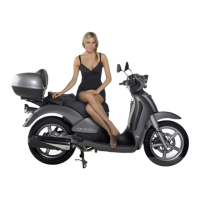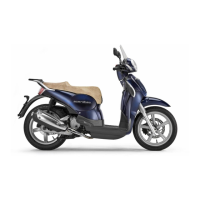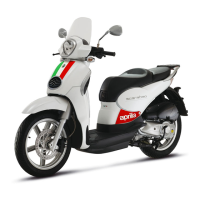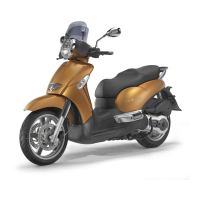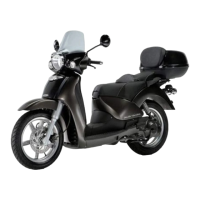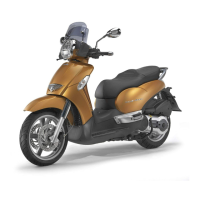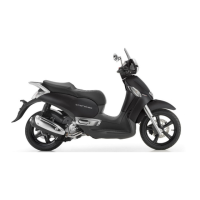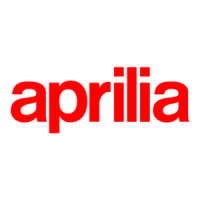
Do you have a question about the APRILIA SCARABEO 125 - 2001 and is the answer not in the manual?
| Year | 2001 |
|---|---|
| Manufacturer | Aprilia |
| Model | Scarabeo 125 |
| Category | Motorcycle |
| Fuel System | Carburetor |
| Transmission | Automatic |
| Front Suspension | Telescopic fork |
| Rear Suspension | Single shock absorber |
| Front Brake | Single disc |
| Seat Height | 790 mm |
| Engine Type | Single cylinder, 4-stroke |
| Max Power | 11.5 hp |
| Rear Brake | Drum |
| Cooling System | Air-cooled |
Explains symbols like WARNING, CAUTION, and NOTE for potential hazards and important information.
Emphasizes reading the manual and maintaining good psychophysical conditions for safe driving.
Highlights the manual's importance, advising dealer contact for clarifications and service.
Explains how to record and use identification data for spare parts and vehicle tracking.
Covers legal driving requirements, gradual vehicle introduction, and alcohol/drug risks.
Stresses good physical/mental state, avoiding distractions, and lending the vehicle to experienced riders.
Advises following road signs, avoiding abrupt movements, and maintaining correct posture.
Guides on avoiding obstacles and slipstream effects for safer riding.
Stresses driver focus, using correct fuels/lubricants, and regular checks.
Advises checking for damage after accidents and reporting any malfunctions promptly.
Warns against modifying vehicle parts, voiding warranty, and impacting safety/legality.
Details requirements for crash helmets, protective attire, and avoiding loose clothing items.
Advises on choosing, installing, and using accessories safely, avoiding electrical issues.
Provides instructions on loading luggage to maintain vehicle balance and security.
Guides on avoiding bulky items, securing bags, and not obstructing lights or controls.
Warns against exceeding load limits and overloading, which affects stability and maneuverability.
Provides a numbered key to identify major parts of the vehicle.
Presents an alternative numbered key for identifying vehicle components.
Details the location and numbering of controls on the left and right handlebars.
Identifies and labels the various instruments and warning lights on the dashboard.
Explains the function of each warning light, odometer, speedometer, and gauge.
Describes the horn, direction indicator switch, and dimmer/high beam controls on the left handlebar.
Details the light switch, start button, and engine stop switch functions on the right handlebar.
Explains the ignition switch operation, key usage, and steering lock mechanism.
Details the steps for locking the steering and the key removal states.
Covers the digital clock display, date/time setting, and battery replacement.
Describes the location and maximum weight limit for the vehicle's bag hook.
Explains the use of the anti-theft hook and the optional armored cable for security.
Details how to lock the saddle and access the crash helmet storage compartment.
Explains how to open the glove compartment and its weight limit.
Covers adjusting the passenger seat and lists the contents of the tool kit.
Provides warnings and instructions for safe refueling, including tank capacity.
Recommends engine and transmission oils, specifying check and change intervals.
Advises on safe oil handling, spill prevention, and contacting dealers for issues.
Details brake fluid checks, disc and pad conditions, and fluid change frequency.
Explains how to check the brake fluid level and what to do if it's low.
Advises checking braking efficiency and contacting a dealer if levers feel soft or response is reduced.
Covers coolant level checks, handling precautions, and disposal warnings.
Warns against removing the expansion tank plug when the engine is hot due to pressure.
Details how to check the coolant level in the expansion tank and the "MIN"/'MAX" marks.
Instructs on safely topping up coolant, avoiding overfilling, and checking for leaks.
Emphasizes periodic checks of tyre pressure at room temperature for optimal performance.
Guides on checking tyre wear, condition, and when to replace them, including valve caps.
Explains the function of the automatic light switching system and its operation.
Advises checking the exhaust silencer for damage and contacting a dealer if noise increases.
Outlines essential pre-ride checks for safety and proper vehicle function.
Covers exhaust gas hazards, starting position, and initial warning light indications.
Details the steps for starting, including light switch position, brake lever engagement, and starter button usage.
Provides guidance for starting the engine in cold conditions, including throttle usage.
Explains how to start the engine if it has become flooded with fuel.
Offers advice for starting the vehicle after extended periods of non-use.
Covers pre-departure checks, passenger instructions, and mirror adjustment.
Instructs on smooth acceleration, proper braking, and avoiding abrupt throttle inputs.
Advises on safe driving in varied conditions, including wet roads and turns.
Emphasizes timely use of indicators and safe overtaking practices.
Details the running-in process, including initial braking advice and speed limits.
Guides on parking the vehicle securely on firm ground and avoiding hazards.
Explains how to use the center stand and the optional side stand for parking.
Lists recommendations for securing the vehicle against theft.
Outlines essential safety steps before performing any maintenance work.
Explains the symbols (1, 2, 3, 4) used in the service intervals chart.
Clarifies the symbols used for maintenance operations performed by the official dealer.
Advises recording frame and engine numbers for spare parts and identification.
Details the procedure for checking the engine oil level using the dipstick.
Guides on adding engine oil, avoiding overfilling, and using appropriate lubricants.
Explains how to remove, clean, and re-oil the air filter element.
Details how to visually inspect brake pad wear and when replacement is necessary.
Guides on inspecting the condition and functionality of the center and side stands.
Outlines checks for front suspension oil and seals, and general suspension component integrity.
Explains how to adjust the rear shock absorber spring preload for different loads.
Details how to check for excessive play or looseness in the steering system.
Guides on periodically checking the engine pin bushings for slack.
Provides steps for removing the central inspection cover.
Explains how to remove the main central fairing section of the vehicle.
Details the procedure for removing and reassembling the rear-view mirrors.
Guides on how to detach and remove the front cover of the vehicle.
Steps to remove the front inspection cover, accessing other components.
Instructions for removing the crash helmet case and its associated parts.
Details the process for removing the front section of the fairing.
Explains how to adjust the engine's idle RPM using the carburetor screw.
Guides on setting the correct idle stroke for the throttle grip.
Details how to check, clean, and gap the spark plug for optimal performance.
Covers checking electrolyte levels, terminal tightening, and safety precautions for battery handling.
Advises on battery care when the vehicle is unused for extended periods.
Provides steps for removing the battery case and cleaning its terminals.
Details the procedure for safely disconnecting and removing the battery.
Explains how to check and replenish the battery's electrolyte level with distilled water.
Guides on recharging the battery and safely installing it back into the vehicle.
Details how to check fuses for breaks and replace damaged ones with correct amperage.
Lists the location and function of each fuse within the vehicle's electrical system.
Explains how to check the operation of the stoplight switches on the brake levers.
Guides on adjusting the headlight beam's vertical position for optimal road illumination.
Covers safety warnings and handling tips for changing bulbs, including fuse checks.
Details the specific steps for replacing indicator light bulbs.
Provides instructions for replacing the main headlight bulb.
Explains the procedure for replacing the parking light bulbs.
Details the process for replacing the rear parking/stoplight and number plate bulbs.
Advises on preparing the vehicle for transport, including fluid emptying and securing.
Provides instructions for completely draining the fuel tank and carburetor.
Offers advice on cleaning the vehicle in various conditions and avoiding damage.
Lists specific warnings and cautions for cleaning different vehicle parts and surfaces.
Details steps for preparing the vehicle for extended periods of inactivity, including fluid management and storage.
Outlines checks required after a period of inactivity before resuming use.
Lists the physical dimensions of the vehicle.
Provides detailed specifications for the engine, including displacement and type.
Lists the required capacities for engine oil, coolant, and fuel.
Presents technical data on the transmission system and carburetor.
Lists technical details for the frame, fuel supply, and suspension components.
Details tyre sizes, types, and recommended inflation pressures.
Lists specifications for the ignition system, spark plug, and electrical components.
Provides wattage for bulbs and voltage/wattage for warning lights.
Identifies all numbered components shown in the wiring diagram.
Lists the colour codes used for electrical cables in the wiring diagram.
Advises customers to always ask for genuine Aprilia spare parts.
Thanks customers and provides advice on environmental responsibility and noise reduction.

